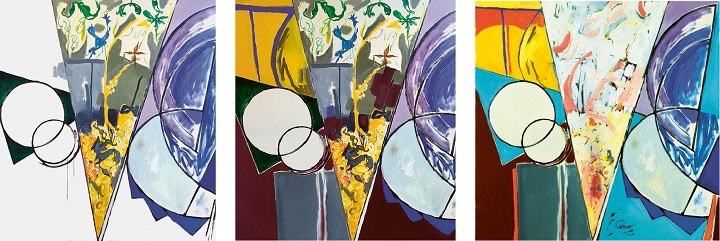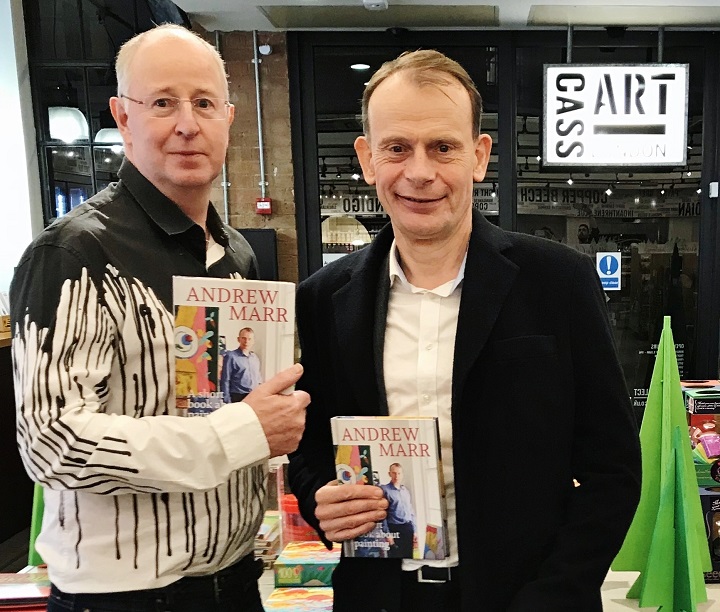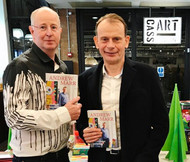Andrew Marr is best known for his long career in political journalism, working for The Scotsman, The Independent, The Economist, and The Observer, and for being the BBC’s Political Editor. Perhaps you’ve seen one of his many documentaries on history, art, science and politics or you watch The Andrew Marr Show on BBC1. But it may surprise some of you to know he is also a prolific painter.

From left to right: Michael Harding, Karyn Harding, Andrew Marr, Mark Cass, Renata Zelich.
Andrew is also a Cass Art customer. He met Cass Art’s Founder and CEO Mark Cass recently and they discussed Andrew’s love of materials, that pigmentation is extremely important to him and that he’s a big
Michael Harding oils fan. Mark invited him to meet Michael to talk about his famous richly pigmented oil colours. As they chatted, Michael revealed that he decided to start making his own colours through frustration. He'd seen a Rembrandt painting and couldn’t seem to find the right tones and pigments in any brands at the time that would help him to achieve such rich colours. And so Michael Harding Oil Colours were born, much to the delight of thousands of artists across the world, not least Andrew Marr. Andrew goes as far as to say he finds colour a physical thrill. There’s a chapter on colour in his recent book
‘A Short Book About Painting’, alongside other chapters on similarly subjective issues of taste and motif.

Walking Near Greenstone, Andrew Marr ©
‘A Short Book About Painting’ allows us into the mind of an artist, how do you make the plethora of decisions necessary to create a work of art? What makes a good painting? What makes a bad painting? And what is it we are all looking for from art? This is no ‘how to’ book, far from it, Andrew says “There’s no point writing a book that someone else has already written. This book is trying to start afresh and find answers to things I haven’t found answers to in any other books.”
We were delighted to have Andrew join us at our Flagship store in Islington to talk more about the book and his artistic process. Seated amongst the sketchbooks and canvases he tells the audience, “I feel like I’m in some kind of temple... This is the kind of place that I come to worship pigments and all the basics of making art”.
Cleaning Windows, Andrew Marr ©
In 2013 Andrew had a serious stroke which changed the way he painted and the way he thought about painting entirely. “One of the things you realise when you have a stroke is that life is really short, and there’s no point putting off what you want to do. I was having to give up lots of things because of the stroke... I thought dammit I can’t paint anymore, but then I realised I could, I just had to paint in a studio. Once I started drawing again, I thought ‘yes, I’m still me.’”
He no longer wants to merely paint pretty pictures or replicate the styles of painters from years gone by, and has moved on from ‘representational’ painting to ‘abstract’ - although he hates the word and explains “I don’t think any painting is abstract. Every painting is of something, even if it’s just a painting of a singular colour.”
Summer Picnic, Andrew Marr ©
Andrew is in search of transcendence. An escape from the humdrum, the daily grind that guides us through our brief lives on this beautiful planet. His aims are to capture and communicate the sensation of being alive more intensely than normal through his work. That’s the goal, and it’s no easy task, but that’s ok too. In fact, that’s sort of the point. Andrew says:
“Failure in painting is really important. And we don’t talk about failure enough. I have 20-30 pictures of the same subject, making different mistakes in every one… What does it mean to make a success of a mistake? Those are the really interesting questions that we need to look at today.”
He’s right of course, all the while we’re failing we’re learning, and this drives us to create more, to fail more, but to fail better. He shows us a painting he made, ‘Summer Picnic’ which he was initially pleased with, but now considers it a failure. He feels it lacks coherence and has a particular dislike of the mixture of styles of painting on one canvas, telling us “You can’t mix representational and non-representational in the same painting.”

He goes on to show us a selection of images of the various stages of a painting, though he mostly makes work based on nature and his surroundings, the concept of this one is political, and expresses his concerns about the disruption and damage likely to be caused by the tunnelling for the new high speed rail link to Birmingham in his local area in North London. He talks us through the step by step decision making, first the composition, then the colour, then his struggle with leaning too much towards representational painting in the central section, and finally pulling it back to abstraction leaving him satisfied with the final piece.

The book takes us through examples of other artists’ works too, ones Andrew considers a success and others that are not so lucky. He applauds Schwitters for his originality, Rauschenberg for his eclectic use of materials, Kiefer for his ability to assault the physical viewer and Basquiat for his ‘explosive pictures which are brimming with life’. Obvious choices perhaps, but he also has a lot of praise for contemporary painters, for example Jason Martin and Adrian Hemming for the surface texture of their paintings and Clare Woods for her ability to represent the reality of nature. Jeff Koons however, in Andrew’s opinion falls short where these artists excel, he finds his work ‘utterly dead’.
Winter in the Studio, Andrew Marr ©
So if painting is so difficult, wrought with endless errors, failure and changes of heart, why bother to paint at all? The final chapter in the book tackles this issue. It’s about immortality, sending a message to the future of what it’s like to be alive right now.
“I’m trying to find ways of representing in paint moments and feelings… to use paint as a metaphor for different human experiences, to get a better perspective on this business of being alive. My family will mock me when I go to the studio ‘oh he’s trying to be immortal again’”
For anyone interested in painting, for anyone who has ever painted, this book will feel very familiar indeed. It’s a comforting arm around the shoulder of the struggling artist, reminding us it will all be worth it in the end. If nothing else, it will make you appreciate the myriad of decisions necessary to achieve transcendence.

Mark Cass and Andrew Marr at Cass Art Islington
Image credits: All artwork images Andrew Marr ©
From left to right: Michael Harding, Karyn Harding, Andrew Marr, Mark Cass, Renata Zelich.
Andrew is also a Cass Art customer. He met Cass Art’s Founder and CEO Mark Cass recently and they discussed Andrew’s love of materials, that pigmentation is extremely important to him and that he’s a big Michael Harding oils fan. Mark invited him to meet Michael to talk about his famous richly pigmented oil colours. As they chatted, Michael revealed that he decided to start making his own colours through frustration. He had seen a Rembrandt painting and couldn’t seem to find the right tones and pigments that would help him to achieve such rich colours in any brands at the time. And so Michael Harding Oil Colours were born, much to the delight of thousands of artists across the world, not least Andrew Marr. He goes as far as to say he finds colour a physical thrill. There’s a chapter on colour in his recent book ‘A Short Book About Painting’, alongside other chapters on similarly subjective issues of taste and motif.











